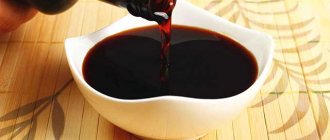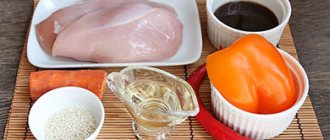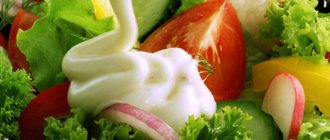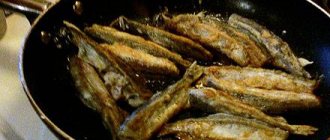Updated: December 23, 2020, at 10:27 am
- 6.1 Author of the publication
The task we have set for ourselves is to tell users in this article about the calorie content of soy sauce, how to use it correctly when losing weight, what needs to be taken into account when purchasing, who is useful or, conversely, harmful. We have left for you several accessible recipes that you can repeat yourself at home.
How many calories are in soy sauce
Soy sauce is an integral component of oriental cuisine; the Chinese have long owned the recipe for its preparation. The natural sauce is prepared by fermenting soybeans. Interestingly, this process lasts two whole years. Store shelves are lined with artificial products that are very tasty, but not particularly healthy.
It is impossible to name the number of calories in soy sauce because companies that produce such a product use different ingredients, but the average calorie content of soy sauce per 100 grams is approximately 51 kcal, protein is 8 g (24 kcal), carbohydrates are 6.6 g (27 kcal). ), no fat, dietary fiber 0.8 g, sugar 0.4 g.
The calorie content of one tablespoon of soy sauce (15-20 g) is from 7.5 to 10 kcal, and 1 teaspoon is from 2.5 to 3.5 kcal, mono- and disaccharides are 6.66 grams, and ash is 5.67 g .
- produces a soy product with a caloric value of 25 kcal, proteins here are 6.3 g, there are no carbohydrates and fats, the composition is characterized by the presence of soy, sugar, water, salt, peanuts, stabilizers, preservatives, dyes.
- 100 grams of seasoning contains 183 kcal, protein ratio 2.6 g, no fat, carbohydrates 43 grams. The list of ingredients includes sugar, soy extract, salt, yeast, lactic acid, spices, caramel, water, glucose, spices.
- The soy product is different from others, it is produced by fermenting soybeans, it is aged in time, it is rich, and it has a special taste. Calories 119 kcal, proteins 4.8 grams, no fat, carbohydrates 25.1 grams.
It is necessary to take a reasonable approach to the consumption of soy sauce, no matter how tasty and cheap it may be. Due to the presence of sodium and preservatives, artificial foods can be harmful to the body, so it is better to eat natural ones. They are, of course, more expensive, but more useful, 20 ml per day is enough.
It is forbidden to eat the seasoning for pregnant women and children under 5 years of age, patients with pathologies of the liver, kidneys, cholecystitis, and impaired intestinal motility.
People will have to say goodbye to this food ingredient forever after a stroke, heart attack, diabetes, high blood pressure, gastritis, or thyroid disease. Even in healthy people, excessive consumption of soy sauce can cause nausea, heartburn, and severe abdominal pain.
Soy sauce: calories, protein, fat, carbohydrates
The task we have set for ourselves is to tell users in this article about the calorie content of soy sauce, how to use it correctly when losing weight, what needs to be taken into account when purchasing, who is useful or, conversely, harmful. We have left for you several accessible recipes that you can repeat yourself at home.
How many calories are in soy sauce
Soy sauce is an integral component of oriental cuisine; the Chinese have long owned the recipe for its preparation. The natural sauce is prepared by fermenting soybeans. Interestingly, this process lasts two whole years. Store shelves are lined with artificial products that are very tasty, but not particularly healthy.
It is impossible to name the number of calories in soy sauce because companies that produce such a product use different ingredients, but the average calorie content of soy sauce per 100 grams is approximately 51 kcal, protein is 8 g (24 kcal), carbohydrates are 6.6 g (27 kcal). ), no fat, dietary fiber 0.8 g, sugar 0.4 g.
The calorie content of one tablespoon of soy sauce (15-20 g) is from 7.5 to 10 kcal, and 1 teaspoon is from 2.5 to 3.5 kcal, mono- and disaccharides are 6.66 grams, and ash is 5.67 g .
- produces a soy product with a caloric value of 25 kcal, proteins here are 6.3 g, there are no carbohydrates and fats, the composition is characterized by the presence of soy, sugar, water, salt, peanuts, stabilizers, preservatives, dyes.
- 100 grams of seasoning contains 183 kcal, protein ratio 2.6 g, no fat, carbohydrates 43 grams. The list of ingredients includes sugar, soy extract, salt, yeast, lactic acid, spices, caramel, water, glucose, spices.
- The soy product is different from others, it is produced by fermenting soybeans, it is aged in time, it is rich, and it has a special taste. Calories 119 kcal, proteins 4.8 grams, no fat, carbohydrates 25.1 grams.
It is necessary to take a reasonable approach to the consumption of soy sauce, no matter how tasty and cheap it may be. Due to the presence of sodium and preservatives, artificial foods can be harmful to the body, so it is better to eat natural ones. They are, of course, more expensive, but more useful, 20 ml per day is enough.
It is forbidden to eat the seasoning for pregnant women and children under 5 years of age, patients with pathologies of the liver, kidneys, cholecystitis, and impaired intestinal motility.
People will have to say goodbye to this food ingredient forever after a stroke, heart attack, diabetes, high blood pressure, gastritis, or thyroid disease. Even in healthy people, excessive consumption of soy sauce can cause nausea, heartburn, and severe abdominal pain.
How to use to lose weight
The issue of using soy sauce for weight loss is controversial and does not have a clear answer, regardless of its calorie content. Some nutritionists scare us with the presence of carcinogens, while others, on the contrary, want to interest us in phytoestrogens. Who should you trust?
- Two tablespoons of exotic seasoning contain about 35 kcal, so thickly flavoring dishes will lead to rapid weight gain, a large amount of sodium chloride will lead to an imbalance of water-salt balance, which will have a detrimental effect on health. The conclusion suggests itself: uncontrolled consumption will lead to cellulite, weight gain, and thirst.
- Nutritionists insist that you should not eat more than one or two tablespoons; some advise giving it up altogether during a diet, but there is a middle ground: you can eat one that consists of water, a small amount of sugar, beans or miso paste, and salt. The Japanese are very fond of this product; traditional diets include it in all dishes: cereal porridges, side dishes, meat, fish, salads, seafood.
- When losing weight, salt consumption is limited, so soy seasoning can successfully replace it and help remove excess fluid from the body, but the consumption rate cannot be exceeded; those who are losing weight should remember this.
- Nutritionists recommend using the product during a 14-day buckwheat diet. The Dukan diet includes exotic seasoning in the list of allowed ingredients for the first 3-10 days, when the body is supplied with proteins.
- With a salt-free diet, it is allowed to season soups and salads with fresh vegetables.
- The rice diet also requires seasoning; this is the only type of seasoning allowed; salt and sugar are prohibited; consumption of up to 2 liters of liquid per day is required, including kefir and yogurt.
- Products such as cottage cheese, cheese, kefir do not go well with soy supplements; they should be excluded during weight loss to avoid stomach upset.
- Obesity is eliminated if you choose the right popular product when purchasing.
- Some manufacturers, chasing profit, add hydrochloric acid during production, so carefully study the labeling on the bottle, try to choose one that says “non-GMO.” It should be expensive, the expiration date should be clearly visible. It is made by fermentation, which means that the label contains the following inscription: beans, miso paste, flour, water, microorganisms for fermentation. It would be good to listen to the reviews of your friends about this product. This will make your weight loss diet tasty and effective.
With honey and mustard
The calorie content of one hundred grams of product is 119 kcal, proteins 7 grams, fats 6 grams, carbohydrates 50 grams.
| honey | 5 g |
| soy sauce | 60 ml |
| Dijon mustard | 20 g |
| nutmeg | 5 g |
| salt | 1-2 pinches |
| ground pepper mixture | 1-2 pinches |
- Fill a small bowl with soy sauce, carefully add honey, mix the resulting mass thoroughly until the honey dissolves. You can pre-melt it using a slow cooker, this will make the mixing process easier.
- Add Dijon mustard to the resulting mass, add ground nutmeg, a mixture of peppers, salt, and mix again.
- Let sit at room temperature for 5-10 minutes to allow the flavors to meld well.
- You need to marinate the meat for 5 hours, but you will be surprised by the result.
Homemade sushi
Calories 169 kcal, proteins 6 g, fats 4 grams, carbohydrates 35 grams.
| soy sauce | 200 ml |
| onion powder | 20 g |
| garlic powder | 20 g |
| rice | 300 g |
| rice vinegar | 60 ml |
| tofu | 400 g |
| mayonnaise | 120 g |
| dry spices | 20 g |
| chili sauce | 40 g |
| salt | 5 g |
- Let's prepare the sauce for marinating the tofu. To do this, fill a deep bowl with soy sauce, add onion and garlic powder here, add tofu slices to the marinade, leave for half an hour.
- Let's prepare the rice: first wash it several times with cold water, then fill it with clean water, put it on the fire, add salt, cook over low heat for 15 minutes, and keep it off the fire for another 10 minutes.
- Pour rice vinegar into it, add salt, mix, spread on a baking sheet in an even layer, sprinkle dry spices on top.
- We take the tofu out of the marinade, transfer it to a sieve, wait until all the liquid has gone, cut it into thin strips so that it does not crumble.
- Add vegan mayonnaise, mix very carefully, add chili sauce and mix again.
- Then place the tofu on top of the rice, level it, and sprinkle with dry spices again. Place the baking sheet in the oven for 15 minutes at 190 degrees. Serve on a platter using nori leaves.
What does soy sauce contain?
With a calorie content of 53 kcal, soy sauce has the following composition: 4.9 g of carbohydrates, this is 34% of total energy or 20 kcal per 100 grams of product, fats are 0.57 g, proteins 8.14, water 71.51, ash 15, 21, the total sugar content is 0.4 g, fiber 0.8 g.
The composition of vitamins looks like this: PP, B1, B2 (0.2 mg), B3 (2.2 mg), B4 (18.3 mg), B5 (0.3 mg), B6 (0.1 mg), B9 (14.0 mcg). The mineral composition is characterized by a high sodium content: 422.5% of the daily value per 100 grams of product, in addition, there is iron, manganese, potassium (435.0 mg), phosphorus (166 mg), magnesium, calcium (33 mg), selenium, soy seasoning does not contain zinc or fat-soluble acids.
The presence of essential amino acids that the body needs for the structure of proteins, glutamic acid, glycitine, antioxidants (phenols, flavones), which accelerate the metabolic processes of the human body and reduce cholesterol levels in the blood, has also been proven.
What are the benefits of soy sauce?
- If you consume natural soy sauce, you can reap the benefits. For example, antioxidants contained in the sauce prevent aging, have actions necessary for proper cell division, and improve regeneration processes.
- Phytoestrogens hormones are very similar to female sex hormones, but are of plant origin. They help with menopause, relieve symptoms associated with this phenomenon, preserve the functions of the genital organs in young women, ease menstrual cycles, promote long-term fertility, postponing menopause.
- Like any product produced by fermentation, soy sauce has a high percentage of vitamin B, nourishes cells, improves the condition of the skin, soothes nervous breakdowns, and can even relieve headaches. These same vitamins are responsible for good restful sleep and good awakening in the morning.
- It is recommended to use this natural exotic seasoning for cardiovascular diseases, rehabilitation after heart attacks, and atherosclerosis due to the lack of fat.
- It is useful to eat it for those who have intolerance to animal proteins due to individual metabolic characteristics.
- The product has receptor properties and enhances tastes.
- Protects the liver from fibrosis in chronic alcoholic pathologies; may be required for type 2 diabetes for treatment.
about the benefits and harms of soy sauce
This short video will tell you how to choose the right natural soy sauce and teach you how to understand product labeling.
If you are counting calories, then you will probably be interested in knowing what the calorie content of peanuts is and why it is recommended to be consumed during weight loss diets.
Pasta lovers will be interested to know about the calorie content of funchose, what it consists of, and why funchose is called “glass vermicelli.” With proper nutrition, it is recommended to eat vegetables and fruits daily. Due to their low calorie content, tangerines are an excellent snack during a healthy diet.
Pink salmon has a high calorie content, but still, due to its beneficial properties, it must be in every person’s diet.
Tell us how you feel about soy sauce, how often you introduce it into your diet. Have you ever noticed changes in your body after regular use?
Calorie content and benefits of soy sauce Link to main publication
Source: https://w-beauty.ru/zdorove/pitanie/kalorijnost-produktov/soevyj-sous-2.html
How to use to lose weight
The issue of using soy sauce for weight loss is controversial and does not have a clear answer, regardless of its calorie content. Some nutritionists scare us with the presence of carcinogens, while others, on the contrary, want to interest us in phytoestrogens. Who should you trust?
- Two tablespoons of exotic seasoning contain about 35 kcal, so thickly flavoring dishes will lead to rapid weight gain, a large amount of sodium chloride will lead to an imbalance of water-salt balance, which will have a detrimental effect on health. The conclusion suggests itself: uncontrolled consumption will lead to cellulite, weight gain, and thirst.
- Nutritionists insist that you should not eat more than one or two tablespoons; some advise giving it up altogether during a diet, but there is a middle ground: you can eat one that consists of water, a small amount of sugar, beans or miso paste, and salt. The Japanese are very fond of this product; traditional diets include it in all dishes: cereal porridges, side dishes, meat, fish, salads, seafood.
- When losing weight, salt consumption is limited, so soy seasoning can successfully replace it and help remove excess fluid from the body, but the consumption rate cannot be exceeded; those who are losing weight should remember this.
- Nutritionists recommend using the product during a 14-day buckwheat diet. The Dukan diet includes exotic seasoning in the list of allowed ingredients for the first 3-10 days, when the body is supplied with proteins.
- With a salt-free diet, it is allowed to season soups and salads with fresh vegetables.
- The rice diet also requires seasoning; this is the only type of seasoning allowed; salt and sugar are prohibited; consumption of up to 2 liters of liquid per day is required, including kefir and yogurt.
- Products such as cottage cheese, cheese, kefir do not go well with soy supplements; they should be excluded during weight loss to avoid stomach upset.
- Obesity is eliminated if you choose the right popular product when purchasing.
- Some manufacturers, chasing profit, add hydrochloric acid during production, so carefully study the labeling on the bottle, try to choose one that says “non-GMO.” It should be expensive, the expiration date should be clearly visible. It is made by fermentation, which means that the label contains the following inscription: beans, miso paste, flour, water, microorganisms for fermentation. It would be good to listen to the reviews of your friends about this product. This will make your weight loss diet tasty and effective.
Cooking recipes
With honey and mustard
The calorie content of one hundred grams of product is 119 kcal, proteins 7 grams, fats 6 grams, carbohydrates 50 grams.
| honey | 5 g |
| soy sauce | 60 ml |
| Dijon mustard | 20 g |
| nutmeg | 5 g |
| salt | 1-2 pinches |
| ground pepper mixture | 1-2 pinches |
- Fill a small bowl with soy sauce, carefully add honey, mix the resulting mass thoroughly until the honey dissolves. You can pre-melt it using a slow cooker, this will make the mixing process easier.
- Add Dijon mustard to the resulting mass, add ground nutmeg, a mixture of peppers, salt, and mix again.
- Let sit at room temperature for 5-10 minutes to allow the flavors to meld well.
- You need to marinate the meat for 5 hours, but you will be surprised by the result.
Homemade sushi
Calories 169 kcal, proteins 6 g, fats 4 grams, carbohydrates 35 grams.
| soy sauce | 200 ml |
| onion powder | 20 g |
| garlic powder | 20 g |
| rice | 300 g |
| rice vinegar | 60 ml |
| tofu | 400 g |
| mayonnaise | 120 g |
| dry spices | 20 g |
| chili sauce | 40 g |
| salt | 5 g |
- Let's prepare the sauce for marinating the tofu. To do this, fill a deep bowl with soy sauce, add onion and garlic powder here, add tofu slices to the marinade, leave for half an hour.
- Let's prepare the rice: first wash it several times with cold water, then fill it with clean water, put it on the fire, add salt, cook over low heat for 15 minutes, and keep it off the fire for another 10 minutes.
- Pour rice vinegar into it, add salt, mix, spread on a baking sheet in an even layer, sprinkle dry spices on top.
- We take the tofu out of the marinade, transfer it to a sieve, wait until all the liquid has gone, cut it into thin strips so that it does not crumble.
- Add vegan mayonnaise, mix very carefully, add chili sauce and mix again.
- Then place the tofu on top of the rice, level it, and sprinkle with dry spices again. Place the baking sheet in the oven for 15 minutes at 190 degrees. Serve on a platter using nori leaves.
What does soy sauce contain?
With a calorie content of 53 kcal, soy sauce has the following composition: 4.9 g of carbohydrates, this is 34% of total energy or 20 kcal per 100 grams of product, fats are 0.57 g, proteins 8.14, water 71.51, ash 15, 21, the total sugar content is 0.4 g, fiber 0.8 g.
The composition of vitamins looks like this: PP, B1, B2 (0.2 mg), B3 (2.2 mg), B4 (18.3 mg), B5 (0.3 mg), B6 (0.1 mg), B9 (14.0 mcg). The mineral composition is characterized by a high sodium content: 422.5% of the daily value per 100 grams of product, in addition, there is iron, manganese, potassium (435.0 mg), phosphorus (166 mg), magnesium, calcium (33 mg), selenium, soy seasoning does not contain zinc or fat-soluble acids.
The presence of essential amino acids that the body needs for the structure of proteins, glutamic acid, glycitine, antioxidants (phenols, flavones), which accelerate the metabolic processes of the human body and reduce cholesterol levels in the blood, has also been proven.
Calorie content of buckwheat with soy sauce per 100 grams
The calorie content of buckwheat with soy sauce and vegetables per 100 grams is 99.8 kcal. In a 100 gram serving of the dish:
To prepare buckwheat with soy sauce you need:
- soak 1 cup of dried mushrooms in boiled water for 40 minutes;
- fry in vegetable oil 1 piece. finely chopped onions and grated 100 g carrots;
- Pour 1 cup of buckwheat in equal parts into 2 pots, fill the porridge with water in a ratio of 2 parts water to 1 part buckwheat, add soaked mushrooms and fried vegetables to the porridge;
- salt the resulting mixture to taste;
- add 2 tablespoons of soy sauce to each serving;
- cook buckwheat in the oven at 220 °C for 45 minutes.
What are the benefits of soy sauce?
- If you consume natural soy sauce, you can reap the benefits. For example, antioxidants contained in the sauce prevent aging, have actions necessary for proper cell division, and improve regeneration processes.
- Phytoestrogens hormones are very similar to female sex hormones, but are of plant origin. They help with menopause, relieve symptoms associated with this phenomenon, preserve the functions of the genital organs in young women, ease menstrual cycles, promote long-term fertility, postponing menopause.
- Like any product produced by fermentation, soy sauce has a high percentage of vitamin B, nourishes cells, improves the condition of the skin, soothes nervous breakdowns, and can even relieve headaches. These same vitamins are responsible for good restful sleep and good awakening in the morning.
- It is recommended to use this natural exotic seasoning for cardiovascular diseases, rehabilitation after heart attacks, and atherosclerosis due to the lack of fat.
- It is useful to eat it for those who have intolerance to animal proteins due to individual metabolic characteristics.
- The product has receptor properties and enhances tastes.
- Protects the liver from fibrosis in chronic alcoholic pathologies; may be required for type 2 diabetes for treatment.
Tips for choosing a sauce: avoiding fakes
This product is made from quality beans that are boiled or steamed and then mixed with flour. It is ground from barley or wheat grains, which are roasted before grinding. The color of the sauce depends on what kind of flour was used. It can be dark or light. Salt is added to the mixture of flour and beans, after which the product must undergo a fermentation procedure, which lasts from one month to several years. After all this, of course, the mixture is filtered and poured into a container. When choosing a sauce, first of all look at:
- Compound. No dyes or preservatives are added to the product, made naturally. The mixture itself acts as an antiseptic, so it does not spoil for a long time. In this regard, the product should contain only 4 sub-items: soybeans, wheat/barley, water and salt. Any other impurities and flavor enhancers prove that you are being offered a fake. The sauce may have been made using hydrogen chloride to speed up the breakdown of proteins.
- Taste and color. Soy sauce has a rich smell and taste. Products that have been prepared using chemicals to speed up fermentation have neither odor nor rich taste, so artificial enhancers must be used to create the desired effect. They add a chemical taste to the sauce. In addition, all amplifiers are indicated in the composition. Pay attention to the color too, as it should be almost transparent, but with a red-brown tint. An overly dark mixture was most likely prepared artificially.
- Tara. The natural product can only be stored in glass containers. In plastic, for example, the real mixture will quickly deteriorate, so all packaging made from other materials contains a fake.
Soy milk: revealing all the secrets from “A” to “Z”
Video: Soy sauce benefits and harms
Video about the benefits and harms of soy sauce
This short video will tell you how to choose the right natural soy sauce and teach you how to understand product labeling.
If you are counting calories, then you will probably be interested in knowing what the calorie content of peanuts is and why it is recommended to be consumed during weight loss diets.
Pasta lovers will be interested to know about the calorie content of funchose, what it consists of, and why funchose is called “glass vermicelli.” With proper nutrition, it is recommended to eat vegetables and fruits daily. Due to their low calorie content, tangerines are an excellent snack during a healthy diet.
Pink salmon has a high calorie content, but still, due to its beneficial properties, it must be in every person’s diet.
Tell us how you feel about soy sauce, how often you introduce it into your diet. Have you ever noticed changes in your body after regular use?








